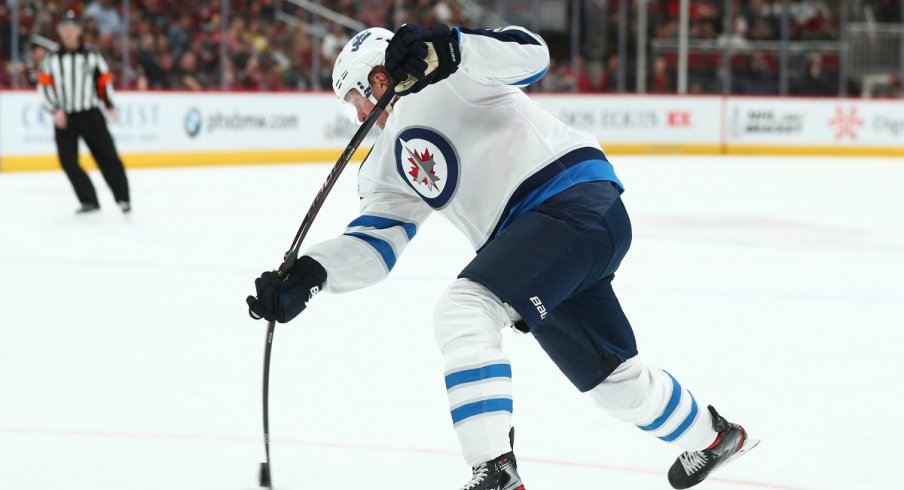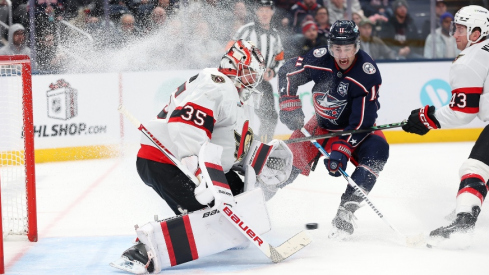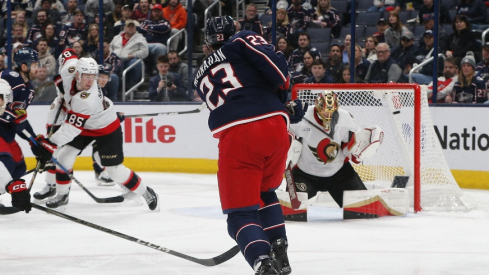The Columbus Blue Jackets acquired Patrik Laine with the expectation that he would, upon arrival, become the team's most dangerous offensive weapon.
The 22-year-old star finds himself in pretty heady company. Since entering the NHL in 2016-17, his 140 regular-season goals rank 10th in the NHL in goals scored, behind only Alex Ovechkin, Auston Matthews, David Pastrnak, Leon Draisaitl, Nikita Kucherov, Connor McDavid, John Tavares, Brad Marchand, and Patrick Kane. In an attempt to better understand what makes Laine tick, I watched every one of his goals. In watching his goals, I had a few takeaways, some of which are obvious, others less so:
- He's perhaps under-appreciated as a net-front player and as a playmaker
- While he isn't a prolific skater or transporter of the puck, he's effective at finishing plays on the rush
- While his one-timer is his ace, he has other weapons on in-zone plays (he can beat goalies clean with a wrist shot right off a face-off, for example)
- His one-timer is ridiculous and is the inspiration for this piece
In an attempt to keep this piece digestible, we're going to focus on his bread and butter: that patented one-timer.
It's not hyperbole to say that Laine has one of the best one-timers in the NHL today. What makes it exceptional is his uncommon blend of size (6-foot-5, 206 lbs.), power, and technique (more on that in a moment). What makes it unique is his astonishingly large wheelhouse, the area in which he can convert a pass into a rocketship of a shot.
"I've never seen someone shoot the puck that way," Max Domi explained. "I was just talking to Jack (Roslovic) on the ice, saying I can't wait to see this guy shoot a puck on a daily basis. Usually, everyone has a window when you're taking a one-timer. You want it in a specific spot, whether it's between your feet or back, front foot, whatever. You can just put it anywhere and he gets ahold of it."
Roslovic echoed this sentiment in his media availability. "His real signature shot (is) that one-timer from anywhere. It's not that hard to pass it to a guy when his wheelhouse is as big as it is."
From a technical standpoint, Laine's shot profiles differently than Ovechkin, who pulverizes pucks with a violent and frenetic shooting motion. Laine uses a much smaller windup, sometimes just sweeping at the puck. While the puck is coming towards him, he addresses the puck head-on like a golfer, then maximizes his power by rotating his huge frame in one fluid motion on contact. He guides the puck towards his target, often dropping his right knee to the ice for extra stability. All the while, he gets the most out of his tall stick and leans hard on his long stick to create maximum torque.
The result is a masterclass in shooting the puck.
NHL Network's Mike Rupp and Kevin Weekes broke down the similarities and differences between the game's top snipers. "Better scorers have a bigger wheelhouse," Rupp said.
Which is why, at the risk of belaboring the point, I'm so fascinated by Laine's wheelhouse. While the overwhelming majority of players (even NHL players) need the puck to be in a relatively limited area between their feet, Laine can stroke a puck from behind his back (right) foot all the way to in front of his left foot. It's otherworldly.
The below videos were compilations of other videos (shoutout YouTube for making this task a bit easier) that I clipped together showing Laine's ability to crank a puck off a) his back heel or b) off his front toe cap, each with a frightening amount of effectiveness. Based on volume alone (I counted 45 goals), the easy conclusion is that he prefers the puck back in his stance.
Even though he's scored far fewer goals off of his front foot (13), he's shown that he can contort his body to these awkward passes all the same.
The Blue Jackets will need to find a way to give Laine as many opportunities as possible to unleash his one-timer. On a power play, this should be an easier proposition, where the penalty kill will (obviously) be at a numerical disadvantage. As the below tweet indicates, Laine had ample opportunity to bomb away from the left dot on Winnipeg power plays over the past four seasons. The Blue Jackets should do everything in their power to continue that trend.
One of my favorite features of @InStatHockey is the ability to isolate an area on the ice and track efficiency.
— Ian Beckenstein (@ibeecks) January 26, 2021
This is Patrik Laine 2016-2020 all PP 5v4 regular season shot attempts. #HockeyTwitter pic.twitter.com/Xvl2wmnWPQ
That, alone, should help a power play that is ranked 28th in the NHL since Laine's rookie season (for reference, Winnipeg was 7th). But at 5v5, the Blue Jackets should prioritize finding ways to allow Laine to use his best asset, as it immediately becomes the greatest single asset possessed by anyone on the club. Look for Domi, who could be a match made in heaven due to his high-end playmaking skills, to defer to Laine often.
The deficiencies in Laine's game are well-chronicled and in some ways overblown. He's not going to win the Selke Trophy, sure, but the Blue Jackets are hoping that what he brings to a goal-starved forward group, particularly on a power play that has stunk out loud for the better part of the last five years, outweighs his (perceived) one-dimensional game.
Laine is more than just a one-timer, but it is his competitive advantage over virtually the rest of the NHL. As such, the Blue Jackets will need to find every way possible to activate this cheat code into their offense. The sooner they can integrate, the better off they will be.
Stay tuned for a follow-up breakdown of what the Blue Jackets power play should look like to support Laine.


